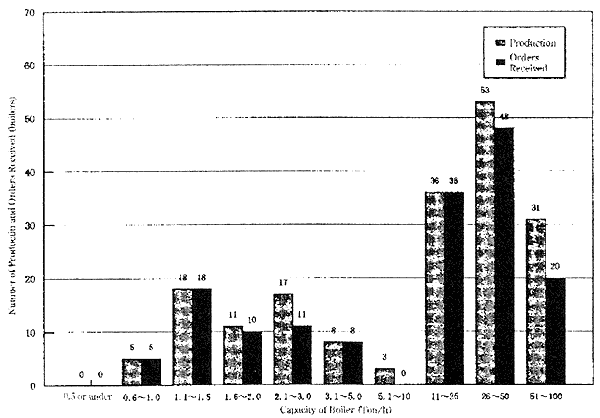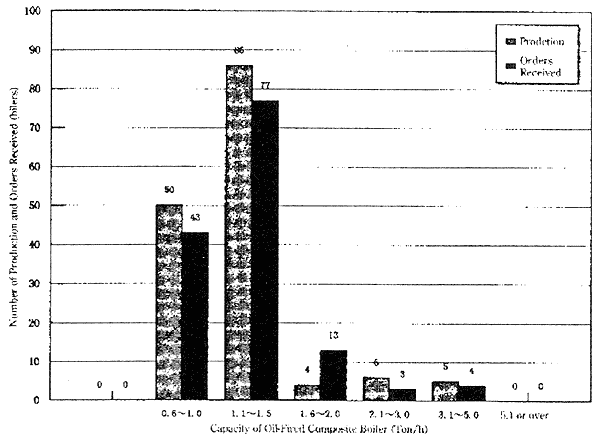Boilers for LNG carriers are delivered to Korean Gas Project and to Qatar-Japan Project.
MES has delivered the boilers for 10 series of LNG carriers intended for Qatar since 1997, but, after the delivery of the fourth LNG carrier, they were requested to control the discharge of the exhaust gas from boilers (in particular, the discharge of black smoke when LNG carriers arrive at/leave the LNG gas station) so that the exhaust gas is invisible in the sea trial of the fifth and subsequent LNG carriers. The target numerical value to be achieved was decided to be approximately 2.5 or under with reference to the measurement value using a SMOKE DENSITY METER through the discussion with the Owner, and MES improved the ACC air control system and the burner swirler, and achieved the target value in the sea trial. Though the demands on main boilers for LNG carriers will be continuously expected, such requests will also be increased as the environmental regulation is intensified.
5.3.2 Auxiliary Boiler
One hundred and fifty eight sets of auxiliary boilers and one hundred and fifty one sets of composite boilers were manufactured in 1998 fiscal year.
Fig. 5.3 shows the number of production and the orders received of main and auxiliary boilers by 8 boiler manufacturers in 1998 fiscal year with reference to the boiler capacity. Though the number of the total auxiliary boilers was reduced to approximately 73% compared with that in 1997 fiscal year, the number of construction of VLCCs is increased, and the total capacity of the auxiliary boilers is increased.

Fig. 5.3 Production and Orders Received of Main and Auxiliary Boilers in 1998 Fiscal Year
Fig. 5.4 shows the summary of the number of production and orders received of the composite boilers, and 151 boilers were produced in 1998 fiscal year as the whole, showing the reduction to approximately 89% compared with that in 1997 fiscal year, and there are indications that the construction boom of bulk carriers up to the previous year is completed.

Fig. 5.4 Production and Orders Received of Composite Boilers in 1998 Fiscal Year
In the design of auxiliary boilers, there are no new technological development, but the auxiliary boiler for tankers of MISSION-OM/-D, and the composite boiler MISSION-OC are on the market as the new series continuous to the MISSION-OS/-OL series introduced in 1996 from Orborg Industries, and the line-up of 5 models covering the boiler capacity of 1.0 T/H to 110 T/H has been completed as the MISSION series. The list of the MISSION series is shown in Fig. 5.5.
Discussions on the monitoring system of auxiliary boilers/exhaust gas economizers were completed in the Sub Committee on Boiler Research of the Energy System Research Committee, and based on the findings of the Sub Committee, the trouble shooting of the auxiliary boilers is now on the discussion as the first stage.
5.3.3 Exhaust Gas Economizer
Ninety four sets of exhaust gas economizer were manufactured in 1998 fiscal year, which is about 107% compared with those in 1997 fiscal year.
Fig. 5.6 shows the summary of the number of production and the orders received by 8 boiler manufacturers with reference to the boiler capacity.
Employment of large exhaust gas economizers for turbo generators (T/G) which have been employed on board VLCCs and container carriers has been continuously on the decline from the viewpoint of the economy and the maintenance due to the drop of the exhaust gas temperature (reduction of the energy recovery ratio) as the fuel consumption of main diesel engines is improved, and only one exhaust gas economizer was manufactured in 1996 fiscal year. Though 5 sets of exhaust gas economizer were manufactured since the Post-Panamax container carriers were constructed in 1998, the orders received after the summer, 1998 has been on the decline.
BACK CONTENTS NEXT